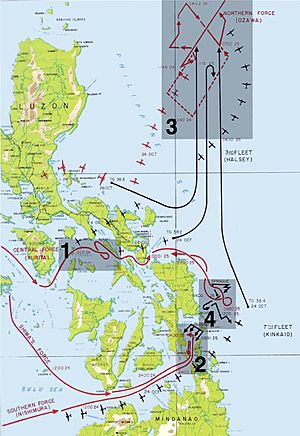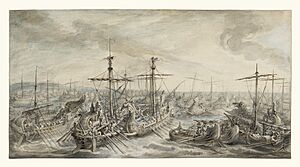Largest naval battle in history facts for kids
Have you ever wondered which naval battle was the biggest in history? It's a tricky question! People disagree on what "biggest" means. Does it mean the most ships, the most people, or the most important battle? Old records often make numbers seem much larger than they were. But we can still look at some amazing battles.
Contents
How We Measure Big Battles
In 1975, a historian named Helmut Pemsel created a way to score naval battles. He gave points for different things:
- Number of ships or people: (1 to 4 points)
- Strategic importance: (0 to 2 points) This means how much the battle changed the war.
- Tactical skill: (0 to 2 points) This is about how well the battle was fought.
- Political importance: (0 to 1 point) This means how much the battle affected countries or leaders.
Using this system, the Battle of Leyte Gulf scored the highest with 8 points. Six other battles tied for second place with 7 points each. These included famous battles like Salamis, Actium, and Jutland.
Here are some of the battles often called the "largest" in history:
Battle of Salamis (480 BC)
This battle happened in September 480 BC. A fleet of 371 Greek ships fought against 600 to 900 Persian ships. The Greeks won a huge victory near Athens. Some believe up to 1,271 ships were involved. This makes it one of the biggest battles by ship count. Greek ships called triremes usually had about 200 crew members.
Battle of Cape Ecnomus (256 BC)
This was a major victory for Ancient Rome against its rival, Ancient Carthage. It took place during the First Punic War. The Roman fleet had about 140,000 people on board. This included rowers, sailors, and soldiers. The number of Carthaginian fighters is less clear. But some historians think it was around 150,000. If these numbers are right, it could be the largest naval battle by the number of people fighting.
Battle of Red Cliffs (208–209 CE)
This battle happened in China during the winter of 208–209 CE. A smaller allied force of 50,000 defeated a much larger force of at least 220,000. The exact numbers are hard to know now. But some sources suggest it might have been the largest battle in terms of total participants.
Battle of Yamen (1279)
On March 19, 1279, this battle finished the Mongol-led Yuan dynasty's takeover of the Southern Song Dynasty in China. It's said that over 1,000 Song dynasty ships were destroyed. This happened near Yamen, Guangdong, China. While many ships were involved, not all of them were warships.
Battle of Lake Poyang (1363)
This battle took place from August 30 to October 4, 1363. It is claimed to be the largest naval battle by the number of people. Reports say 850,000 sailors and soldiers were involved! A Ming dynasty rebel force of 200,000 fought a Han rebel force of 650,000. The battle happened on Lake Poyang, China's largest freshwater lake.
Battle of Jutland (1916)
This huge battle happened during World War I from May 31 to June 1, 1916. The German and British navies fought near Jutland, Denmark. The German fleet had 16 large battleships, 5 battle cruisers, and many smaller ships. The British fleet was even bigger, with 28 battleships, 9 battle cruisers, and many other ships. Britain lost more ships and people. But the battle was a strategic win for Britain. It kept the German fleet from leaving port. In terms of the total weight of all the ships, it was the largest surface battle ever.
Battle of the Philippine Sea (1944)
This was the biggest aircraft carrier battle in history. It happened on June 19–20, 1944. Fifteen American aircraft carriers and nine Japanese carriers were involved. There were also 170 other warships and about 1,700 aircraft. The U.S. Fifth Fleet's Fast Carrier Task Force was the largest group of naval ships ever to fight in one battle.
Battle of Leyte Gulf (1944)

This battle took place from October 23–26, 1944. It is often called the largest naval battle ever. This is because of the total weight of all the ships involved. The United States and Australian navies fought against Japanese forces. The Allied forces had 8 large aircraft carriers, 18 escort carriers, 12 battleships, 24 cruisers, and 141 destroyers. They also had about 1,500 aircraft. The Japanese had 1 large carrier, 9 battleships, 19 cruisers, and 34 destroyers. About 200,000 people fought in total.
The Battle of Leyte Gulf was actually made up of four main battles:
- The Battle of the Sibuyan Sea
- The Battle of Surigao Strait
- The Battle off Samar
- The Battle off Cape Engaño
These battles were part of one big Japanese plan to stop the Allied invasion of Leyte. Even though they were spread out over a few days and hundreds of miles, they are counted as one huge event.



